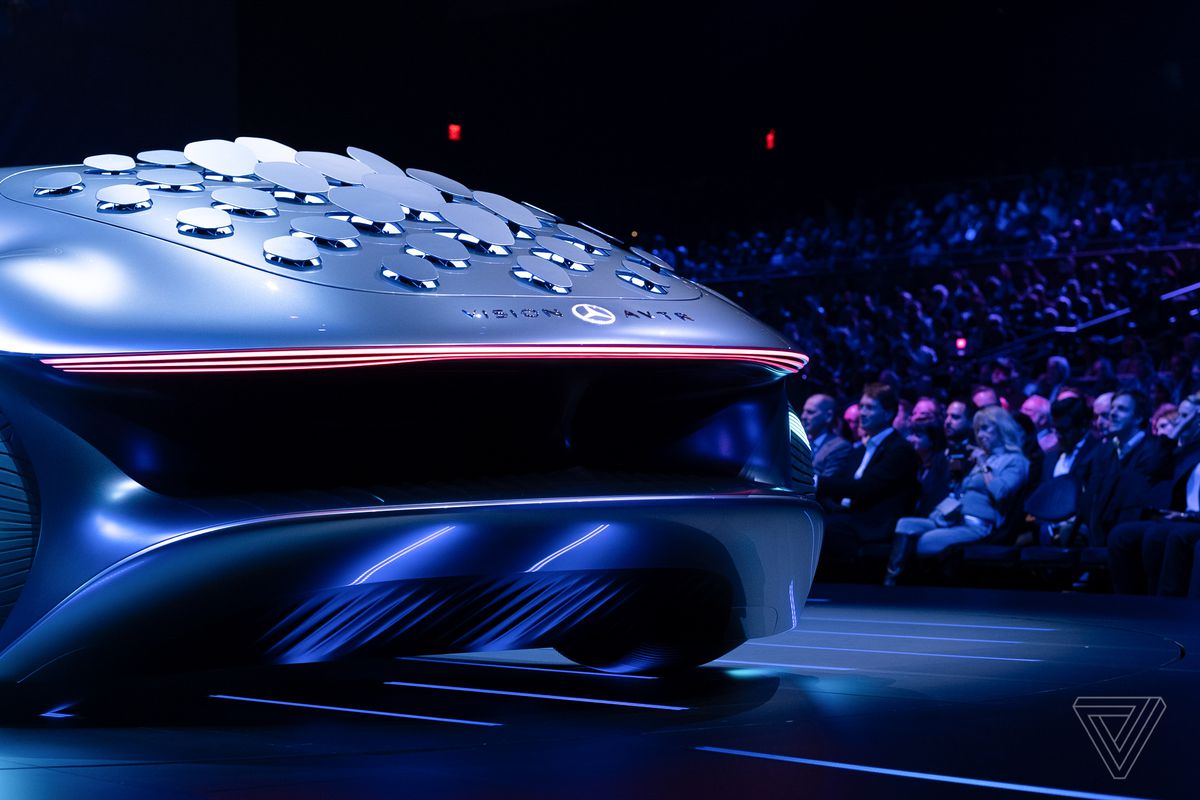Mercedes-Benz has just pulled the wraps off of a wild new concept car that was inspired by the 2009 movie Avatar called — what else? — the Mercedes-Benz Vision AVTR. Designed with help from Avatar director James Cameron, this car is not the sequel that Cameron has promised. Instead, the AVTR concept car is a mix of everything that the Consumer Electronics Show is known for: outlandish styling, far-off future tech, and a tie-in with a major entertainment property. Oh, and it has scales!
Yes, the entire rear end of the AVTR is covered in 33 discrete scales — or as Mercedes-Benz calls them, “bionic flaps” — that the company says could be used to communicate with people outside the car. It also has special spherical wheels that Mercedes-Benz says were inspired by the “seeds of the Tree of Souls” from 2009’s Avatar. These wheels can rotate so that the AVTR can move sideways, or even diagonally.
:no_upscale()/cdn.vox-cdn.com/uploads/chorus_asset/file/19580707/mercedes_vision_avtr_0487.jpg)
Like all concept cars, the Vision AVTR is meant to tease out what it will be like to ride in a car of the future. And while the inside of the car is relatively sparse, Mercedes-Benz has a lot of ideas about what might be possible inside something like the AVTR.
That starts with the lack of steering wheel. Since this futuristic car is obviously (theoretically) autonomous, there’s no need for one. Instead, passengers interact with the car through an oval-shaped controller that accordions up and out of the center console to meet your hand. Once your hand is on the controller, it (and the seats) can vibrate along with the pace of your breathing and heart rate. Ola Källenius, the chairman of Mercedes-Benz’s parent company Daimler, said on stage Monday night that it’s an example of how man and machine might “literally merge.”
To that end, Mercedes-Benz likens this — seriously — to how the Na’vi physically connect with their banshees in the 2009 movie Avatar. And once passengers start moving in the AVTR car, the sweeping display in front of them can light up with 3D graphics of Pandora, the fictional world from the 2009 film Avatar. After Cameron joined Källenius on stage, he agreed with the chairman’s claim. “We will merge,” Cameron said.
:no_upscale()/cdn.vox-cdn.com/uploads/chorus_asset/file/19580684/mercedes_vision_avtr_0462.jpg)
If flying solo through the world of Avatar isn’t your speed, Mercedes-Benz imagines the AVTR car will be able to detect when a family is on board and adapt automatically. The company didn’t go too deep into what kinds of family features it would surface, though it did say in its 23-page press release that parents will be able to monitor their children from the dashboard screen. Rejoice, as the burden of turning around to tell your kids to stop hitting each other is no more. And if children (or as Mercedes-Benz calls them in one instance in the press release, “inmates”) start feeling lonely, fear not, because there will be a light that mimics the breathing vibration to let them know they have not yet been abandoned by their parents. But that won’t be a problem in the first place, because back-seat riders will have access to learning-oriented gaming and a “child-friendly augmented reality experience.”
Mercedes-Benz also spent a lot of time on Monday night talking about how it designed the Vision AVTR with sustainability in mind. The concept car is “powered” by graphene-based organic battery cells that don’t require rare earth minerals, which the company says may one day be compostable, and the interior is made from recycled plastics and vegan leather. (It does not seem to employ any unobtanium, though.) Mercedes-Benz reps even said in a briefing that they believe the special spherical wheels would make less of an impact on the forest floor, should someone drive the AVTR there.
Mercedes-Benz is pushing this angle hard because, like the other major automakers, the company committed to a long-term goal of reducing its carbon footprint. It therefore sees something like AVTR as a literal and metaphorical vehicle for communicating those goals.
:no_upscale()/cdn.vox-cdn.com/uploads/chorus_asset/file/19580708/mercedes_vision_avtr_0496.jpg)
:no_upscale()/cdn.vox-cdn.com/uploads/chorus_asset/file/19580706/mercedes_vision_avtr_0497.jpg)
:no_upscale()/cdn.vox-cdn.com/uploads/chorus_asset/file/19580705/mercedes_vision_avtr_0499.jpg)
:no_upscale()/cdn.vox-cdn.com/uploads/chorus_asset/file/19580704/mercedes_vision_avtr_0500.jpg)
:no_upscale()/cdn.vox-cdn.com/uploads/chorus_asset/file/19580703/mercedes_vision_avtr_0503.jpg)
:no_upscale()/cdn.vox-cdn.com/uploads/chorus_asset/file/19580702/mercedes_vision_avtr_0505.jpg)
:no_upscale()/cdn.vox-cdn.com/uploads/chorus_asset/file/19580701/mercedes_vision_avtr_0506.jpg)
:no_upscale()/cdn.vox-cdn.com/uploads/chorus_asset/file/19580700/mercedes_vision_avtr_0511.jpg)
:no_upscale()/cdn.vox-cdn.com/uploads/chorus_asset/file/19580699/mercedes_vision_avtr_0515.jpg)
Photography by Vjeran Pavic / The Verge
